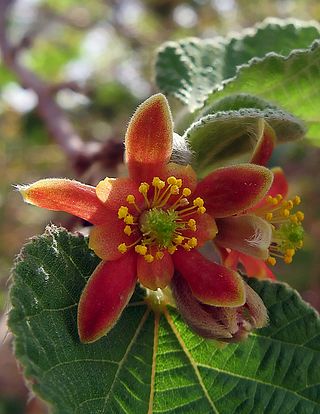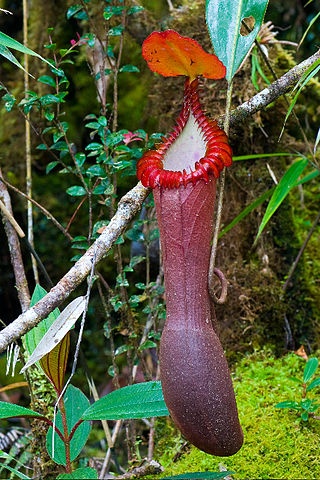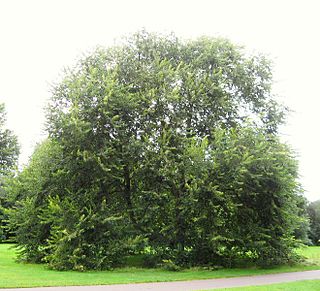
Grewia villosa is a shrub, often scrambling and hardly exceeding 4 m in height. Leaves are fairly large, serrated and heart-shaped. It grows naturally, mainly in dry habitats. It is common in most of the semi-arid parts of Eastern Africa but may now be rare in parts of its natural distribution. It can be seen in Ein Gedi oasis in Israel, and in South Africa, where it is common. Its ripe copper-coloured fruits are eaten in East Africa.

Nepenthes villosa, or the villose pitcher-plant, is a tropical pitcher plant endemic to Mount Kinabalu and neighbouring Mount Tambuyukon in northeastern Borneo. It grows at higher elevations than any other Bornean Nepenthes species, occurring at elevations of over 3,200 m (10,500 ft). Nepenthes villosa is characterised by its highly developed and intricate peristome, which distinguishes it from the closely related N. edwardsiana and N. macrophylla.

Nepenthes edwardsiana, or the splendid pitcher-plant, is a carnivorous tropical pitcher plant endemic to Mount Kinabalu and neighbouring Mount Tambuyukon in Sabah, Malaysian Borneo. It is considered one of the most spectacular of all Nepenthes, producing some of the largest pitchers and the most highly developed peristome ribs of any species in the genus.

Nepenthes macrophylla, the large-leaved pitcher-plant, is a tropical pitcher plant known only from a very restrictive elevation on Mount Trusmadi in Sabah, Malaysian Borneo.

Ulmus villosa, the cherry-bark elm or Marn elm, is one of the more distinctive Asiatic elms, and a species capable of remarkable longevity. It is endemic to the valleys of the Kashmir at altitudes of 1,200–2,500 metres but has become increasingly rare owing to its popularity as cattle fodder. Mature trees are now largely restricted to temples and shrines where they are treated as sacred. Some of these trees are believed to be over 800 years old.

Acaciella angustissima is most recognized for its drought tolerance and its ability to be used as a green manure and ground covering. It is a perennial, deciduous, and belongs to the family Fabaceae (beans/legumes) and as it grows it starts as a shrub but eventually matures to a small tree. The tree has a high density of leaves along with small clumps of white flowers and creates 4–7 cm long seed pods. Acaciella angustissima is found in tropical areas around the equator since, its water needs can vary from 750 to 2,500 mm a year. It has an advantage it can withstand a moderate drought, since its leaves are retained even in long dry periods. Aside from being drought tolerant, Acaciella angustissima also has the benefit of being a green manure, since it has such a high leaf density, but also loses the majority of its leaves each season. So the leaves can be used in composting or can be saved and used as livestock feed. It should only be used as an additive to the feed and not the main source, since it also toxic in high doses.

Syringa josikaea, the Hungarian lilac, or Lady Josika's lilac is a species of lilac in the olive family Oleaceae, native to central and eastern Europe, in the Carpathian Mountains in Romania and western Ukraine. A large shrub, it has a very restricted range, although fossils assigned to the species suggest a much wider prehistoric distribution in central Europe. Today it is threatened in the wild by habitat destruction, but is also commonly used in gardening.
Scalesia villosa is a species of flowering plant in the family Asteraceae. It is found only in the Galápagos Islands of Ecuador. It is threatened by habitat loss.

The Chinese nuthatch or snowy-browed nuthatch is a species of bird in the family Sittidae. It is a small nuthatch, measuring 11.5 cm (4.5 in) in length. The upperparts are blue-gray and the underparts from a dull buff-grayish to a cinnamon-orange; the cheeks are white. There is a marked sexual dimorphism: the adult male is distinguished by its very black crown, while that of the female is the same blue-grey as the back, or at most dark gray when the plumage is worn. In both sexes, a dark gray eyestripe extends in front of and behind the eye, topped by a clear white supercilium separating it from the crown. The song is variable, and composed of repetitions of small invariant whistles. The species feeds mainly on insects in summer and completes its diet with seeds and fruits. The nest is generally placed in the hole of a conifer. The pairs raises one brood per year, with five or six chicks.
Saurauia villosa is a species of plant in the Actinidiaceae family. It is endemic to the Mesoamerican countries of Mexico, Guatemala, El Salvador, and Honduras. It is a small tree found in cloud forests, as well as pine-oak forests and secondary forests.

Wikstroemia villosa, the hairy wikstroemia or hairy false ohelo, is a tropical species of plant in the Thymelaeaceae family.

Acaciella is a Neotropical genus of flowering plants in the legume family, Fabaceae, and its subfamily Mimosoideae. Its centre of diversity is along the Mexican Pacific coast. They are unarmed, have no extrafloral nectaries and the polyads of their pollen are 8-celled. Though its numerous free stamens is typical of Acacia s.l., it has several characteristics in common with genus Piptadenia. Its pollen and free amino acids resemble that of Senegalia. Molecular studies place it sister to a monophyletic clade comprising elements of genus Acacia, and the tribe Ingeae. A nectary ring is present between the stamens and ovary, in common with Acacia subg. Aculeiferum.

The hairy-tailed antsangy is a species of rodent in the family Nesomyidae. It is found only in Madagascar.

Wurfbainia villosa, also known by its basionym Amomum villosum, is a plant in the ginger family that is grown throughout Southeast Asia and in South China. Similar to cardamom, the plant is cultivated for its fruits, which dry into pods when mature and contain strongly aromatic seeds. W. villosa is an evergreen plant in the ginger family, grow in the shade of the tree, 1.5 to 3.0 m high, whose branches and leaves are similar to ginger's. W. villosa has a characteristic that flowers spread on the ground can bear fruit while flowers on the branches can not. Its flowers bloom in March and April and are the colour of white jade.
The Choctaw bean is a species of freshwater mussel, an aquatic bivalve mollusc in the family Unionidae. This species is found in the southeastern United States and is currently on the endangered species list. The species epithet and the common name are based on the name of the Choctaw people, Native Americans who were originally from the southeastern United States.

Photinia villosa is a species in the flowering plant family Rosaceae, with common names Christmas berry and oriental photinia. It is a shrub or small tree up to 5 metres (16 ft) tall, native to China, Japan, and Korea. This plant was recently introduced into the United States, likely as a landscaping or garden plant. It has escaped cultivation and has become increasingly invasive in northern New Jersey, eastern Pennsylvania, and parts of Virginia, New York and Connecticut.

Sideroxylon mascatense is a species of flowering plant in the family Sapotaceae.

Serruria villosa, the golden spiderhead, is a flower-bearing shrub that belongs to the genus Serruria and forms part of the fynbos. The plant is native to the Western Cape, where it occurs only on the Cape Peninsula and just south of Constantia. The shrub is erect and grows only 50 cm tall and bears flowers from April to July.
Xerochlamys villosa is a tree in the family Sarcolaenaceae. It is endemic to Madagascar.
















